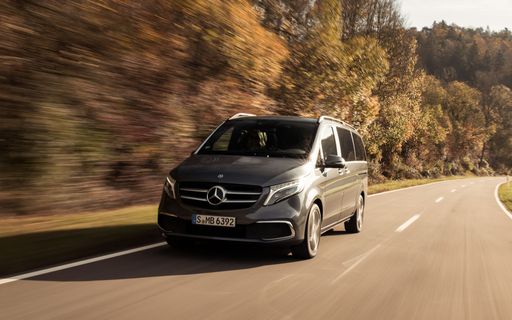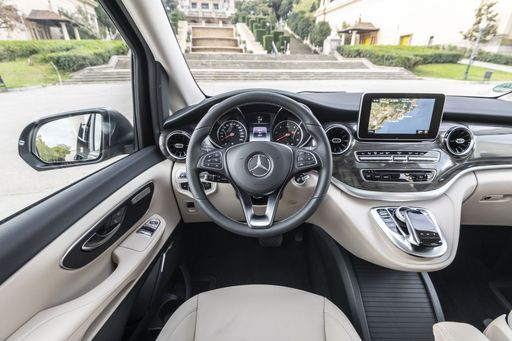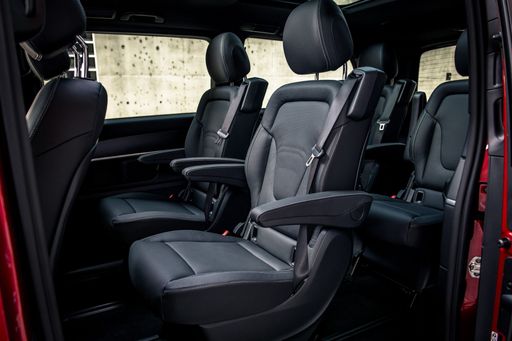Mercedes V Class vs Toyota Proace City Compact Van – Which one offers the better deal?
Compare performance, boot capacity, efficiency and price at a glance.
Find out which car is the better choice for you – Mercedes V Class or Toyota Proace City Compact Van?
Costs and Efficiency:
Price and efficiency are key factors when choosing a car – and this is often where the real differences emerge.
Toyota Proace City Compact Van has a decisively advantage in terms of price – it starts at 21200 £, while the Mercedes V Class costs 48200 £. That’s a price difference of around 26984 £.
Fuel consumption also shows a difference: Toyota Proace City Compact Van manages with 5.40 L and is therefore clearly perceptible more efficient than the Mercedes V Class with 7.10 L. The difference is about 1.70 L per 100 km.
Engine and Performance:
Power, torque and acceleration say a lot about how a car feels on the road. This is where you see which model delivers more driving dynamics.
When it comes to engine power, the Mercedes V Class has a convincingly edge – offering 237 HP compared to 136 HP. That’s roughly 101 HP more horsepower.
In acceleration from 0 to 100 km/h, the Mercedes V Class is convincingly quicker – completing the sprint in 7.40 s, while the Toyota Proace City Compact Van takes 11.10 s. That’s about 3.70 s faster.
In terms of top speed, the Mercedes V Class performs slightly better – reaching 220 km/h, while the Toyota Proace City Compact Van tops out at 186 km/h. The difference is around 34 km/h.
There’s also a difference in torque: Mercedes V Class pulls evident stronger with 500 Nm compared to 300 Nm. That’s about 200 Nm difference.
Space and Everyday Use:
Cabin size, boot volume and payload all play a role in everyday practicality. Here, comfort and flexibility make the difference.
Seats: Mercedes V Class offers a bit more seating capacity – 6 vs 5.
In curb weight, Toyota Proace City Compact Van is decisively lighter – 1358 kg compared to 2192 kg. The difference is around 834 kg.
In maximum load capacity, the Mercedes V Class performs to a small extent better – up to 5010 L, which is about 710 L more than the Toyota Proace City Compact Van.
When it comes to payload, Toyota Proace City Compact Van barely noticeable takes the win – 921 kg compared to 908 kg. That’s a difference of about 13 kg.
Who wins the race?
The Mercedes V Class proves to be has the upper hand and therefore becomes our DriveDuel Champion!
Mercedes V Class is the better all-rounder in this comparison.

Mercedes V Class
Mercedes V Class
The Mercedes-Benz V-Class exemplifies luxury and versatility in the world of multi-purpose vehicles. Its spacious interior is designed to accommodate both family adventures and executive travel with supreme comfort. With advanced technology and premium materials, the V-Class offers an unparalleled driving experience that seamlessly blends practicality with elegance.
details @ group-media.mercedes-benz.com
@ group-media.mercedes-benz.com
 @ group-media.mercedes-benz.com
@ group-media.mercedes-benz.com
 @ group-media.mercedes-benz.com
@ group-media.mercedes-benz.com
 @ group-media.mercedes-benz.com
@ group-media.mercedes-benz.com
Toyota Proace City Compact Van
The Toyota Proace City is a versatile compact van designed to cater to the needs of businesses and families alike. With its spacious interior and efficient engine options, it ensures a comfortable and agile driving experience, making it ideal for urban and suburban environments. The Proace City also offers a range of advanced safety features and connectivity options, ensuring both security and convenience on the road.
details

|
|
|
|
|
Costs and Consumption |
|
|---|---|
|
Price
48200 - 83300 £
|
Price
21200 - 37700 £
|
|
Consumption L/100km
7.1 - 10.2 L
|
Consumption L/100km
5.4 - 6.6 L
|
|
Consumption kWh/100km
-
|
Consumption kWh/100km
18.50 kWh
|
|
Electric Range
-
|
Electric Range
337 km
|
|
Battery Capacity
-
|
Battery Capacity
-
|
|
co2
187 - 232 g/km
|
co2
0 - 150 g/km
|
|
Fuel tank capacity
57 - 70 L
|
Fuel tank capacity
50 - 61 L
|
Dimensions and Body |
|
|---|---|
|
Body Type
Bus
|
Body Type
Cargo Van
|
|
Seats
6
|
Seats
2 - 5
|
|
Doors
5
|
Doors
4 - 5
|
|
Curb weight
2192 - 2464 kg
|
Curb weight
1358 - 1837 kg
|
|
Trunk capacity
610 - 1410 L
|
Trunk capacity
-
|
|
Length
4895 - 5370 mm
|
Length
4401 - 4751 mm
|
|
Width
1928 mm
|
Width
1848 mm
|
|
Height
1901 - 1908 mm
|
Height
1860 mm
|
|
Max trunk capacity
4200 - 5010 L
|
Max trunk capacity
3300 - 4300 L
|
|
Payload
636 - 908 kg
|
Payload
560 - 921 kg
|
Engine and Performance |
|
|---|---|
|
Engine Type
Diesel, Petrol
|
Engine Type
Electric, Diesel, Petrol
|
|
Transmission
Automatic
|
Transmission
Automatic, Manuel
|
|
Transmission Detail
Automatic Gearbox
|
Transmission Detail
Reduction Gearbox, Manual Gearbox, Automatic Gearbox
|
|
Drive Type
Rear-Wheel Drive, All-Wheel Drive
|
Drive Type
Front-Wheel Drive
|
|
Power HP
163 - 237 HP
|
Power HP
102 - 136 HP
|
|
Acceleration 0-100km/h
7.4 - 10.7 s
|
Acceleration 0-100km/h
11.1 - 13.2 s
|
|
Max Speed
188 - 220 km/h
|
Max Speed
135 - 186 km/h
|
|
Torque
370 - 500 Nm
|
Torque
205 - 300 Nm
|
|
Number of Cylinders
4
|
Number of Cylinders
3 - 4
|
|
Power kW
120 - 174 kW
|
Power kW
75 - 100 kW
|
|
Engine capacity
1950 - 1999 cm3
|
Engine capacity
1199 - 1499 cm3
|
General |
|
|---|---|
|
Model Year
2025
|
Model Year
2024
|
|
CO2 Efficiency Class
G
|
CO2 Efficiency Class
A, E
|
|
Brand
Mercedes-Benz
|
Brand
Toyota
|
Is the Mercedes V Class offered with different drivetrains?
Available configurations include Rear-Wheel Drive or All-Wheel Drive.
The prices and data displayed are estimates based on German list prices and may vary by country. This information is not legally binding.
